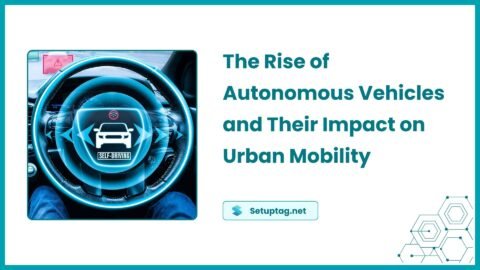How IoT Devices Are Transforming Home Automation and Energy Efficiency

The rise of the Internet of Things (IoT) has brought significant changes across various sectors, particularly in home automation and energy efficiency. How IoT Devices Are Transforming Home Automation and Energy Efficiency is a phenomenon that reflects the increasing integration of connected devices into our daily lives, allowing for smarter, more efficient environments. This article delves into the specific ways IoT devices are changing how we perceive and manage our homes, leading to a more sustainable future.
The Basics of Home Automation and IoT
Home automation refers to the control of home appliances and systems through smart technology, enabling seamless interactions between users and their living spaces. The backbone of this technology is the Internet of Things, which connects various devices to the internet, allowing them to communicate with each other and be controlled remotely.
This section explores the foundational concepts behind home automation and how IoT serves as the catalyst for its transformation.
Understanding Home Automation
Home automation encompasses a range of technologies that enhance the convenience, security, and efficiency of residential environments. From lighting and climate control to smart appliances, home automation integrates multiple functions to create a cohesive system.
An essential aspect of home automation is user control. Many systems allow homeowners to adjust settings via mobile applications or voice commands, providing unparalleled flexibility. This capability not only simplifies daily tasks but also fosters greater engagement with energy consumption patterns.
Moreover, home automation plays a critical role in optimizing energy efficiency. With smart thermostats and lighting systems, users can monitor and adjust their usage based on real-time data, ensuring minimal waste without sacrificing comfort.
Introduction to IoT
The Internet of Things (IoT) refers to the interconnected network of physical devices embedded with sensors, software, and other technologies to collect and exchange data over the internet. In the realm of home automation, IoT devices enable communication between various household gadgets, enhancing seamless integration and functionality.
With cloud computing and advanced analytics, IoT devices can process vast amounts of data to learn user preferences and automate responses accordingly. This intelligence allows for predictive analytics, where devices anticipate user needs, further streamlining energy usage and enhancing overall efficiency.
The Role of Connectivity
The functionality of IoT devices hinges on their ability to connect and share information. Wireless communication protocols like Wi-Fi, Zigbee, and Bluetooth facilitate these connections, allowing devices to work cohesively.
For instance, a smart thermostat can communicate with a weather service to adjust indoor temperatures based on external conditions. Similarly, smart lighting can adapt to occupancy detected through motion sensors. These interactions exemplify how connectivity drives the effectiveness of home automation systems.
Benefits of IoT Devices in Home Automation
As IoT devices become increasingly prevalent, the benefits they offer in terms of home automation and energy efficiency grow substantially. This section will highlight some of the key advantages of using IoT technology to transform our living spaces.
Enhanced Energy Management
One of the primary benefits of IoT devices in home automation is significantly improved energy management. Smart thermostats, for example, monitor temperature settings in real-time and can adjust heating and cooling based on occupancy and preferences.
By learning user habits, smart thermostats can optimize energy usage, ultimately leading to reduced utility bills. Furthermore, integrating these devices with solar energy systems enhances sustainability, as they can direct excess energy to battery storage or the grid as needed.
Moreover, smart meters provide real-time feedback on energy consumption. By monitoring usage patterns, households can identify areas of improvement and reduce energy wastage effectively.
Increased Convenience
IoT devices streamline home automation by offering unparalleled convenience. For instance, smart speakers enable voice-controlled command of various devices, allowing homeowners to manage their environments hands-free.
Additionally, homeowners can set schedules for appliances, such as washing machines or dishwashers, to operate during off-peak hours, maximizing energy efficiency. Integration with mobile apps provides remote control capabilities, ensuring users can manage their homes even while away.
Furthermore, smart locks and security cameras enhance safety and peace of mind. Homeowners can monitor their properties in real time and receive alerts about suspicious activities, all from their smartphones.
Improved Security
Security is a crucial concern for homeowners, and IoT devices play a vital role in improving safety. Smart surveillance systems equipped with motion detection alert homeowners of any unusual activity.
Moreover, smart doorbells allow users to see who is at their door through live video feeds, adding an extra layer of security. This technology enables remote communication, allowing individuals to interact with visitors even when they are not at home.
Additionally, IoT devices can work together to create a comprehensive security ecosystem. For example, if a smart lock detects unauthorized access attempts, it can trigger alarms and notify the homeowner simultaneously.
Sustainability and Environmental Impact
The integration of IoT devices into home automation contributes significantly to sustainability efforts. By optimizing energy consumption and reducing waste, these technologies help minimize environmental footprints.
Moreover, smart irrigation systems can deliver precise amounts of water to gardens and lawns based on weather forecasts and soil conditions, conserving water resources.
Incorporating renewable energy sources also becomes more manageable with IoT technology. Smart devices can effectively manage energy flow, ensuring efficient utilization and reducing reliance on fossil fuels.
| Benefit | Description |
|---|---|
| Enhanced Energy Management | Optimize energy usage and reduce bills |
| Increased Convenience | Streamlined control through voice and mobile access |
| Improved Security | Advanced monitoring and alerts for safe environments |
| Sustainability | Minimized environmental impact through efficiency |
Challenges in Implementing IoT in Home Automation
Despite the numerous benefits associated with how IoT devices are transforming home automation and energy efficiency, several challenges hinder widespread adoption. Understanding these obstacles is crucial for addressing them effectively.
Privacy Concerns
One of the most pressing challenges surrounding IoT devices is the issue of privacy. As smart devices collect and transmit personal data, concerns arise regarding the security of this information.
Homeowners may be wary of potential hacking incidents or unauthorized access to sensitive data, such as daily routines and preferences. Manufacturers must prioritize robust security measures to protect users from breaches and ensure data privacy remains intact.
To mitigate privacy concerns, users should educate themselves about device settings and best practices for securing their networks. Regular updates, strong passwords, and two-factor authentication can further safeguard personal information.
Interoperability Issues
Another challenge lies in the interoperability of various IoT devices. Many manufacturers produce devices that may not easily communicate with one another due to differing protocols or compatibility issues.
To overcome this challenge, industry standards and frameworks are necessary to enable seamless integration among diverse devices. Collaborations between manufacturers and developers can foster an ecosystem where IoT devices work harmoniously, enhancing user experience.
Dependence on Internet Connectivity
IoT devices rely heavily on stable internet connections for optimal performance. In regions with unreliable internet service, the functionality of these devices may be compromised, limiting their benefits.
Homeowners must consider the reliability of their internet service providers before investing in smart devices. Moreover, backup systems, such as local processing of data, can help maintain functionality even in low-connectivity scenarios.
Cost Considerations
While many IoT devices offer long-term savings through increased efficiency, the initial investment can be a barrier for some homeowners. The cost of purchasing and installing smart devices may deter potential users.
However, it’s essential to view these investments from a long-term perspective. Over time, reduced energy bills and increased convenience can offset the initial costs, making IoT solutions more appealing.
FAQs
What is home automation?
Home automation refers to the use of technology to control household systems and appliances, enhancing convenience, security, and energy efficiency.
How do IoT devices improve energy efficiency?
IoT devices optimize energy usage by monitoring consumption patterns, adjusting settings based on real-time data, and facilitating better management of energy resources.
Are there security risks associated with IoT devices?
Yes, IoT devices can pose security risks if not properly managed. Users must implement security measures, such as strong passwords and regular updates, to protect their systems.
Can all appliances be automated?
Not all appliances are designed for automation; however, many modern devices come equipped with smart capabilities, making them compatible with IoT systems.
Is it expensive to install IoT devices?
While there may be upfront costs associated with purchasing and installing IoT devices, the long-term savings from reduced energy bills can make them a worthwhile investment.
Conclusion
In summary, how IoT devices are transforming home automation and energy efficiency represents a pivotal shift in the way we interact with our living spaces. From enhanced energy management and increased convenience to improved security and sustainability, the benefits offered by IoT devices are profound. Although challenges remain in terms of privacy, interoperability, and cost considerations, ongoing advancements in technology continue to pave the way for a smarter, more efficient future in home automation. Embracing these innovations is not just a trend but a step toward creating a sustainable environment for generations to come.









